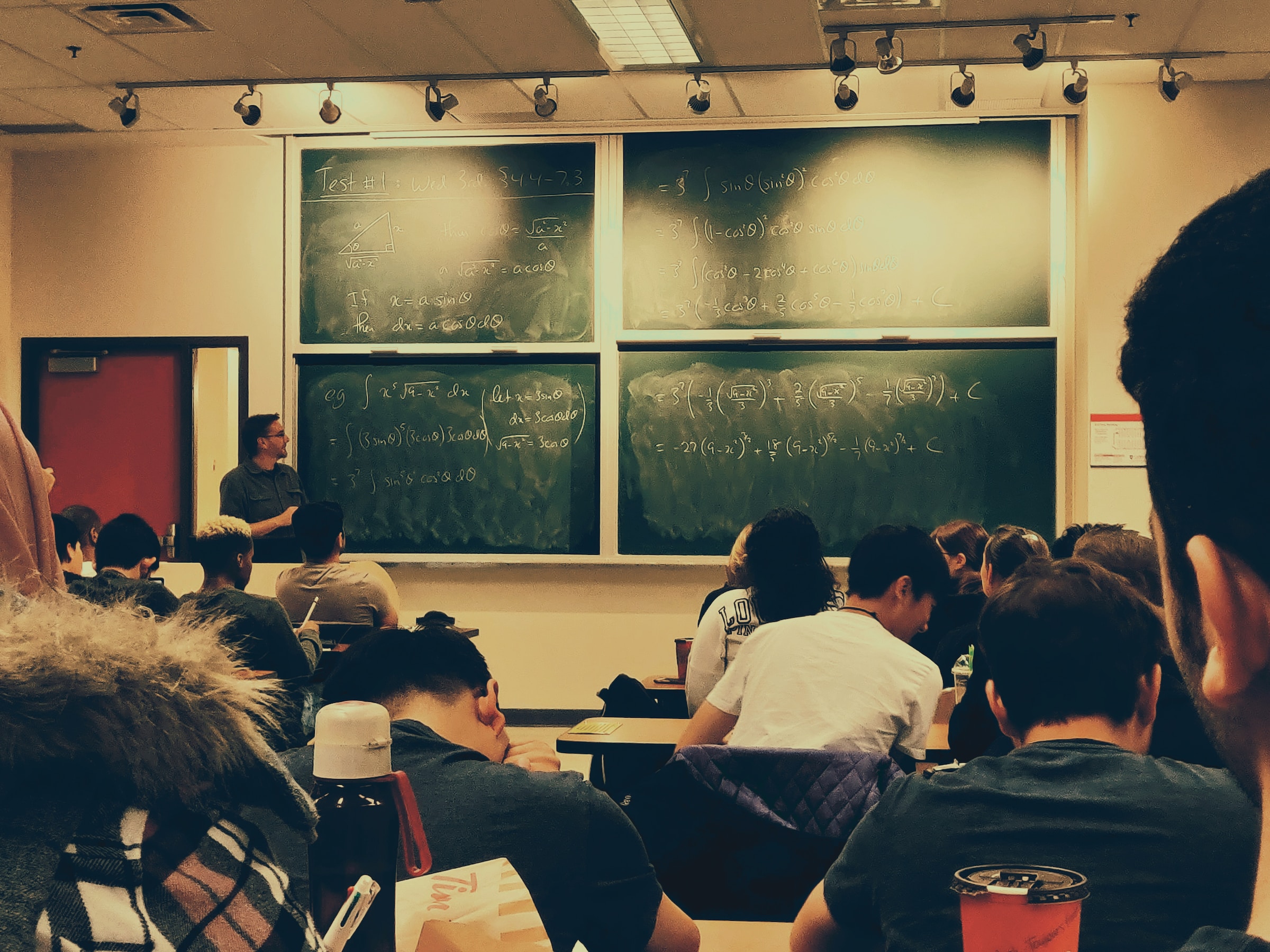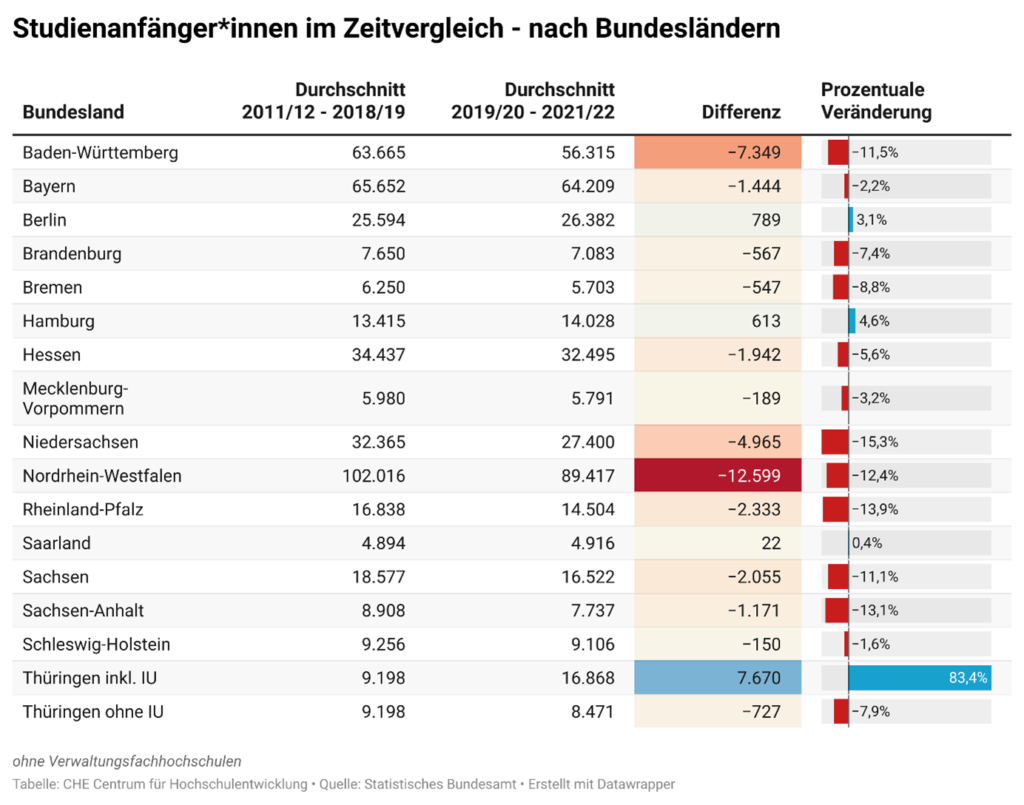 Foto: Unsplash
Foto: UnsplashAfter years of record levels, significantly fewer first-year students are now enrolling at higher education institutions (HEIs) in Germany. The impact of the decline on HEIs and subjects varies from region to region, as an analysis by the CHE Centre for Higher Education shows. Germany’s federal states with the highest losses are North Rhine-Westphalia, Baden-Württemberg and Lower Saxony. The biggest decline in the number of first-year students is in the subjects of mechanical engineering and economics. In contrast to the general trend, private universities were able to significantly increase their population of first-year students, whereas state-run universities experienced substantial losses.
For decades, the number of first-year students in Germany rose to a peak of 445,000 in winter semester (WS) 2011/12. After stagnating at this high level, figures have now been decreasing significantly since WS 2019/20, falling to below 400,000 again for the first time in WS 2021/22. One reason for this development is the decline in the number of births in Germany between 1990 and 2011.
North Rhine-Westphalia has an average of 12,600 fewer first-year students
An analysis by the CHE Centre for Higher Education has now compared the average numbers of university entrants during the stagnation phase (2011/12 – 2018/19) with those in the current phase of decline (2019/20 – 2021/22). The figures are based on the number of first-year students in their first semester in the relevant winter semester. The comparison shows which regions, types of HEI and subjects are particularly affected by the decline.
Germany’s federal state with the most substantial loss is North Rhine-Westphalia, which has an average of 12,600 fewer first-year students when comparing the two phases. Baden-Württemberg and Lower Saxony are also greatly affected, with a reduction of 7,400 and 5,000, respectively. Looking at the corresponding share in the decline in entrant numbers, Baden-Württemberg, Lower Saxony, North Rhine-Westphalia, Rhineland-Palatinate, Saxony and Saxony-Anhalt each show a loss of more than ten per cent in the comparison periods. The university location with the sharpest decline in the country is Karlsruhe. At the federal state level, there are on average more first-year students in Berlin and Hamburg. Then there is the special case of Thuringia. Given that the headquarters of the private IU International University is now located in this federal state, all of its distance learning students count as being in Thuringia, despite being spread throughout the country.


State-run universities experience losses, but private HEIs make gains, going against the trend
The number of university entrants at state-run HEIs fell by around 10 per cent in the comparison period, i.e. a drop of around 42,000. In absolute numbers, the decline is more pronounced at universities, with a drop of 26,600, than at state-run universities of applied sciences (UAS), which experienced a decrease of 14,200. “The general decline in the number of first-year students in Germany could have been much more pronounced, had it not been for the sharp rise in the number of enrolments at private HEIs,” summarised study author Marc Hüsch. In contrast to the general trend, an average of 15,700 more people enrolled at this type of HEI than before, an increase of around 50 per cent.
Sharp decline in mechanical engineering; increases in applied social studies, computer science, psychology and health sciences
The subject area with the most substantial loss is mechanical engineering/process engineering, which recorded a drop of 10,800 students, i.e. almost one-third fewer first-year students than before. Economics, electrical engineering, information technology and German language and literature are also hard hit. Particularly high absolute gains can only be observed for four subject areas compared over time. These are applied social studies, computer science, psychology, and health sciences. “However, neither the negative nor the positive trends in subjects such as mechanical engineering or computer science are a phenomenon of a sudden drop or increase in the number of first-year students,” emphasised Marc Hüsch. “We have been observing these developments throughout the whole of Germany for several years now,” remarked the project leader of CHE’s Hochschuldaten.de portal.
HEIs must adapt to changing circumstances
When considering the composition of first-year students, it is noticeable that there is a significantly greater decrease of male university entrants, averaging more than 22,500. In contrast, the number of female first-year students fell only slightly, by 3,700. The group of non-German university entrants, on the other hand, has in fact risen by around four per cent.
According to CHE Executive Director Frank Ziegele, HEIs must now adapt to the new circumstances, given that the strong phase of growth is over: “The demographic trend and the associated challenges affect all parts of society. The general skills shortage is further exacerbated by the declining trend in the number of first-year students in subjects such as mechanical engineering and electrical engineering. HEIs should also be aware of this responsibility and closely analyse the development of their intake figures, in order to draw the appropriate conclusions for their university strategy and profile.”
About the analysis:
The “CHECK Entwicklung der Studienanfänger*innen in Deutschland” (CHECK Development of the number of first-year students in Germany) offers a detailed analysis of recent trends in the number of university entrants. The analysis was based on data from the student statistics of the Federal Statistical Office on first-year students (first semester at university) in the relevant winter semester. In the evaluation, special attention was paid to a comparison of the periods 2011/12 to 2018/19 (phase of stagnation in the number of first-year students at a high level) and 2019/20 to 2021/22 (decline in the number of first-year students). In this context, differences among federal states, university locations, types of HEI, university funding bodies, groups of subjects and subject areas were examined. In addition to the CHECK, a short version of the findings is available on the www.hochschuldaten.de portal in the form of a DataCHECK. The CHECK and the DataCHECK were written by Cort-Denis Hachmeister and Marc Hüsch. All the publication’s graphics are available on the CHE Flickr channel.
Bildquelle: Unsplash
CHECK - Entwicklung der Studienanfänger*innen in Deutschland 18. April 2023 2.15 MB 11442 downloads
Hachmeister, Cort-Denis; Hüsch, Marc: CHECK - Entwicklung der Studienanfänger*innen...DatenCHECK 2/2023: Sinkende Zahl an Studienanfänger*innen - eine Detailbetrachtung für Orte und Studienbereiche 18. April 2023 0.00 KB 9613 downloads
Hüsch, Marc: DatenCHECK 2/2023: Sinkende Zahl an Studienanfänger*innen - eine Detailbetrachtung...Link to the short version of the findings in the form of a blog post on the www.hochschuldaten.de portal
